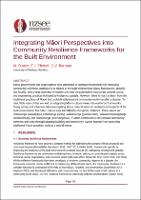| dc.description.abstract | Many governments and organisations have attempted to construct frameworks for improving community resilience, particularly as related to the built environment. Many frameworks take a large overview of society and miss the potential to incorporate cultural, social, and engineering practices followed by indigenous people. However, there is much to learn from the traditional practices of the Maori people that could directly improve community resilience after a disaster. To date, little research has worked on integrating Maori cultural views into resilience frameworks. Using survey and interview data investigating Maori cultural views on resilience and aspects of the built environment, five Maori values were identified to strength resilience. These values include matauranga (knowledge), kotahitanga (unity), kaitaikitanga (guardianship), whakawhanaunga (relationships), and manakitanga (extending love). Further, communities can increase community cohesion and unity through adapting building and community layouts learned from observing traditional Maori practices, such as a central marae, prior to colonisation. | |

